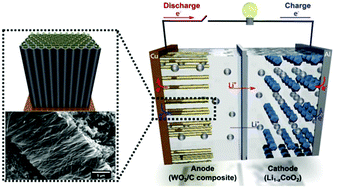Tungsten oxide nanorod architectures as 3D anodes in binder-free lithium-ion batteries†
Abstract
Tungsten oxide nanorods were synthesized using a template assisted process. A polycarbonate membrane (pore diameter 100 nm) was vacuum infiltrated by an aqueous solution of ammonium paratungstate ((NH4)10H2W12O42·xH2O) and yielded crystalline 3D oriented WO3 nanorod arrays after template etching and calcination. By coating the nanorod arrays with carbon, a binder-free 3D WO3/C composite electrode could be fabricated, allowing capacities up to 1149, 811, 699, 559 and 253 mA h g−1 for cycles 1, 2, 20, 50 and 200 as well as a coulombic efficiency of around 99%. Moreover, as prepared WO3 nanorod structures without that specific type of carbon coating deliver capacities in a range of 200–250 mA h g−1 after 20 cycles. Finally, a full cell lithium ion battery system is fabricated. It consists of LiCoO2 nanoparticles as cathode and binder-free carbon coated 3D WO3 composite material as anode. Pre-lithiation of this 3D WO3/C composite material as pre-conditioning before full cell assembly leads to a cell capacity of almost twice of that without pre-lithiation. Discharge capacities of 111, 91, 41 and 23 mA h g−1 can be obtained for cycles 2, 20, 100 and 200 with a coulombic efficiency of around 99% in the case of the pre-lithiated 3D WO3/C composite anode.



 Please wait while we load your content...
Please wait while we load your content...